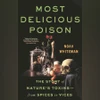MOST DELICIOUS POISON: The Story of Nature’s Toxins — From Spices to Vices
Author: Noah Whiteman
Publisher: Little, Brown/Spark
Pages: 296
Price: $30
Robert Sullivan
More From This Section
What doesn’t kill you might make you stronger. When it comes to nature’s toxins, they might even save your life (or at least blunt the sting of its finality). The distinction, as the evolutionary biologist Noah Whiteman explores in Most Delicious Poison, is all in the dosage.
Take alcohol. Ethanol is likely born of plants’ evolutionary search for protection. Long before the first happy hour, yeast’s alcohol-making evolved as a means for the fungi residing in rotting fruit to survive oxygen deprivation. Ethanol thwarts most microbes; but yeast thrives, burning energy from sugar in oxygen’s absence.
The same ethanol that might jump-start a party can, through addiction, mean the destruction of the liver — not to mention lives. Alcohol’s paradox, Whiteman writes, is tied to ethanol’s ability to mimic (or possibly bind to) gamma-aminobutyric acid — that is, the neurotransmitter our brains use to soften the nervous system’s activity.
Translating to human terms, Whiteman explains, “Drinking relieved my father of serious nerve pain he suffered from a motorcycle accident before I was born.” Alcohol addiction ultimately killed Whiteman’s father, an amateur naturalist who taught his son to take comfort in the natural world while fighting off the pain in his own life.
At the heart of Most Delicious Poison is an evolutionary oxymoron that sustains life as we know it: Poisons — in deserts or rainforests, at the corner bar or in your fridge — threaten life while offering possibilities for persistence, and the pleasures that we take from substances that would otherwise be deadly, hint at the ways life on earth manages to thrive in a landscape of toxins. And in the author’s case, the question clearly has personal meaning.
“Scratch beneath the surface of a coffee bean, a red pepper flake, a poppy capsule, a Penicillium mold, a foxglove leaf, a magic mushroom, a marijuana bud, a nutmeg seed or a brewer’s yeast cell, and we find a bevy of poisons,” Whiteman writes.
Caffeine is another natural wonder best approached with caution. “Caffeine and the human mind,” says Whiteman, can seem like a match made in heaven. “Taken in the appropriate doses, caffeine not only feels life-giving but is: Drink a few cups a day and you won’t live forever but a little longer.” Whiteman sorts through data suggesting as much, though, anecdotally, on a fall morning in the dark, it sure feels true.
But caffeine can be deadly. In October of this year, the parents of a University of Pennsylvania student with a congenital heart condition sued Panera Bread over their “Charged Lemonade,” on the grounds that a substance containing three Red Bulls’ worth of caffeine should have been marketed as an energy drink, potentially saving their daughter’s life.
And yet used in moderation, the poison that we drink in pumpkin spice lattes blocks adenosine receptors — adenosine being a brain-produced neurotransmitter that would otherwise encourage you to rest. Why does caffeine do this? Whiteman points to honeybees, which, in dark hives, share directions in what the neuroethologist Karl von Frisch described in the 1970s as something like GPS translated with gyrations. Plants that have evolved to synthesise caffeine, goes one theory, might offer it to their pollinators, theoretically rendering the bees more flight aware and thus more productive.
Or did plants first develop this wondrous crystalline compound as a potent insecticide? Did its presence in the coffee plant signal stress, as do the salicylic acids that close a plant’s pores, shutting the gate on microbial invasion?
Whiteman’s fieldwork has taken him to the Galápagos, where he studied the DNA of lice on hawks; to Colorado, where today he looks for the genetic and molecular traces of adaptations that result from interactions between species. He is based at the University of California, Berkeley, where he is professor of integrative biology and molecular and cell biology.
Most Delicious Poison is most delicious for its scope: from birds’ judicious digestion of toxic butterflies to the repugnance of rats to the smell of death — rats bury dead rats, in captivity. We see the pathways that relate the piperine in black pepper to Demerol and opioids, and Whiteman tells us that the Alpha??'pinene that makes balsam fir smell lovely for forest bathers once killed a man delivering a tanker of it when, without a respirator, he cleaned out the inside of his truck.
You don’t need a degree in neurophysiology to enjoy the book — though I imagine it would add to the experience, which can at times feel like a riveting lecture by a passionate professor.
Despite the granular approach, the book’s concerns are universal. “Two of the unintended consequences of the obsession and need for natural toxins are the global biodiversity crisis and the global climate crisis,” Whiteman writes in summation. “These twin problems threaten not only our survival as a species but also that of the biosphere itself.”
Big Pharma’s relationship to indigenous knowledge is a recurring motif.
“Indigenous healers have yielded nearly 50 percent of all modern drugs we use today,” writes Whiteman. Western medicine, in his telling, is still playing catch-up, even as this same society devours the lands that are the last strongholds of the very
biodiversity that heals.
But ultimately, however important his larger conclusions, Whiteman’s project is a personal one. In its exploration of the brain’s mesolimbic reward system that taunted his father, the book serves as a love letter to a man whose addictions made him a poisonous parent during what Whitehead calls a “long struggle with nature’s toxins.”
The reviewer is the author of seven books, including The Meadowlands ©2023 The New York Times News Service

)
